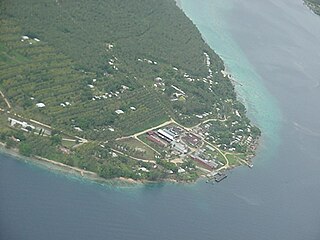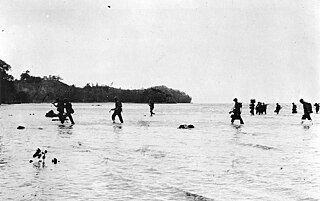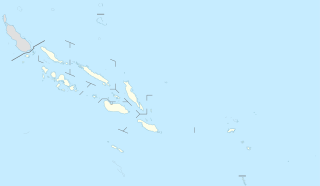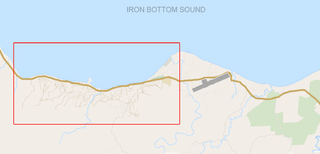
Solomon Islands is a sovereign country consisting of six major islands and over 900 smaller islands in Oceania, to the east of Papua New Guinea and northwest of Vanuatu. It has a land area of 28,400 square kilometres (11,000 sq mi), and a population of 652,858. Its capital, Honiara, is located on the largest island, Guadalcanal. The country takes its name from the Solomon Islands archipelago, which is a collection of Melanesian islands that also includes the North Solomon Islands, but excludes outlying islands, such as the Santa Cruz Islands and Rennell and Bellona.

The New Georgia campaign was a series of land and naval battles of the Pacific campaign of World War II between Allied forces and the Empire of Japan. It was part of Operation Cartwheel, the Allied strategy in the South Pacific to isolate the Japanese base around Rabaul. The campaign took place in the New Georgia group of islands, in the central Solomon Islands and followed the Allied capture of the Russell Islands. The main fighting took place on New Georgia island itself, although significant actions also took place around the island chain throughout the campaign.

Anuta is a small high island in the southeastern part of the Solomon Islands province of Temotu, one of the smallest permanently inhabited Polynesian islands. It is one of the Polynesian Outlier communities in Melanesia.

Fubuki was the lead ship of twenty-four Fubuki-class destroyers, built for the Imperial Japanese Navy following World War I. When introduced into service, these ships were the most powerful destroyers in the world. They served as first-line destroyers through the 1930s, and remained formidable weapons systems well into the Pacific War. Fubuki was a veteran of many of the major battles of the first year of the war, and was sunk in Ironbottom Sound during the Battle of Cape Esperance in World War II.

The Nggela Islands, also known as the Florida Islands, are a small island group in the Central Province of Solomon Islands, a sovereign state in the southwest Pacific Ocean.

Western Province is the largest of the nine provinces of Solomon Islands. The area is renowned for its beautiful tropical islands, excellent diving and snorkelling, coral reefs and WWII wrecks, ecotourism lodges, and head-hunting shrines. The province contains many small lagoons and most of the country's tourist trade outside Honiara.

The Huon-class minehunter coastal (MHC) ships are a group of minehunters built for the Royal Australian Navy (RAN). Following problems with the Bay-class minehunters, a request for tender was issued in 1993 for a class of six coastal minehunters under the project designation SEA 1555. The tender was awarded in 1994 to the partnership of Australian Defence Industries (ADI) and Intermarine SpA, which was offering a variant of the Italian Gaeta-class minehunter.

HMAS Waterhen is a Royal Australian Navy (RAN) base located in Waverton on Sydney's lower north shore, within Sydney Harbour, in New South Wales, Australia. Constructed on the site of a quarry used to expand Garden Island in the 1930s, the location was used during World War II as a boom net maintenance and storage area. In 1962, the area was commissioned as a base of the RAN, and became home to the RAN's mine warfare forces. Waterhen was the first small-ship base established by the RAN, and from 1969 to 1979 was also responsible for the RAN's patrol boat forces.

Isabel Province is one of the provinces of Solomon Islands. The province had a population of around 35,257 as of 2020, mostly concentrated on the main island, Santa Isabel Island. The capital of the province is Buala on Santa Isabel Island, which has scheduled airline services to Honiara on Solomon Airlines from Fera Airport, on Fera Island, a 15-minute boat ride from Buala.

The British Solomon Islands Protectorate was first declared over the southern Solomons in 1893, when Captain Gibson R.N., of HMS Curacoa, declared the southern islands a British protectorate. Other islands were subsequently declared to form part of the Protectorate.

Yandina is the principal town on Mbanika Island in the Russell Islands, located on the east coast of the island, in the Central Province of Solomon Islands. It is a port, and an airport. Yandina is the site of a copra and cocoa plantation and has basic services such as a store, post office, and rest house.

Santa Isabel Island is the longest in Solomon Islands, the third largest in terms of surface area, and the largest in the group of islands in Isabel Province.

The Battle of Tulagi and Gavutu–Tanambogo was a land battle of the Pacific campaign of World War II, between the forces of the Imperial Japanese Navy and Allied ground forces. It took place from 7–9 August 1942 on the Solomon Islands, during the initial Allied landings in the Guadalcanal campaign.
Yandina Airport is an airport on Mbanika in the Solomon Islands.

Pavuvu is the largest of the Russell Islands in Central Province, Solomon Islands. It is located northwest of Guadalcanal. The area is 129.19 square kilometres (49.88 sq mi). The largest village is Nukufero on the north coast.
Marau Sound is a sound in the Solomon Islands; it is located at the eastern end of Guadalcanal Island, in Guadalcanal Province.
Tavanipupu is an island in the Solomon Islands. It is located in Marau Sound, at the eastern end of Guadalcanal, between Towara'o Island and Marapa Island, and is part of Guadalcanal Province.

Operation I-Go was an aerial counter-offensive launched by Imperial Japanese forces against Allied forces during the Solomon Islands and New Guinea Campaigns in the Pacific Theater of World War II. Taking place from 1–16 April 1943, during the operation, Japanese aircraft – primarily from Imperial Japanese Navy units under the command of Admirals Isoroku Yamamoto and Jinichi Kusaka – attacked Allied ships, aircraft, and land installations in the southeast Solomon Islands and New Guinea. The goal of the operation was to halt the Allied offensives in New Guinea and the Solomons and to give Japan time to prepare a new set of defenses in response to recent defeats to the Allies in the Battle of Guadalcanal and in New Guinea at Buna–Gona, Wau, and the Bismarck Sea.

Point Cruz is a peninsula in the center of Honiara, on Guadalcanal Island. Honiara is the capital city of the Solomon Islands. Point Cruz is located on the Tandai Highway, and is ¼ mile north of the Solomon Islands Parliament Building. Point Cruz is in the Honiara City Council ward of Cruz, and is East of Town Ground and West of Tuvaruhu.
The following index is provided as an overview of and topical guide to Wikipedia's articles on recreational dive sites. The level of coverage may vary:



















